1976 Jaguar XJ6 4.2 Coupe Automatic
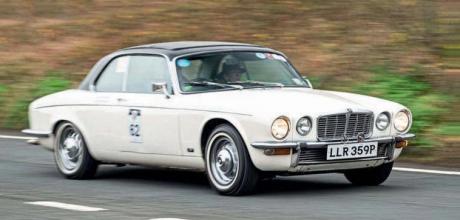
When Roger Knight and his friend Jim Gleeson decided to enter the gruelling LeJog rally in a low-mileage XJ6 4.2 Coupe, they were diving in at the deep end with no previous experience. Words Rob Hawkins Photography Gregory Owain.
DEEP END XJ6 COUPE RESTORATION
After spending 25 years in a barn, the owner restored this XJ6 Coupe at home before using the car to compete in the gruelling LeJog rally
Tony Jardine, ex-Formula One team manager and TV pundit, asked us whether we had done LeJog before, to which we replied we hadn’t,” remarks Jaguar enthusiast Roger Knight, who owns the 1976 XJ6 4.2 Coupe seen here. “He then asked if we’d done any rallying or racing before, assuming we had, and swore when we said we hadn’t.” Whilst LeJog was a sufficient test of stamina and determination, the work involved in making this XJ6C roadworthy was equally demanding. Roger is no stranger to Jaguars and his collection includes aMk 2,E-type,XJS,XKR X100, X-TYPE Sports Premium and an XJR Portfolio.

The XJ6C was discovered when its previous owner had a business meeting with Roger and realised he had a passion for Jaguars. Registered on the 26 April 1976, the first keeper acquired it some 18 months later and kept it for 12 years. The second seemingly planned to use it, but moved abroad with work, so it was parked in a barn from 1992 onwards. Sadly, that second owner died and the XJ6C was passed down through the family, yet it never turned a wheel.
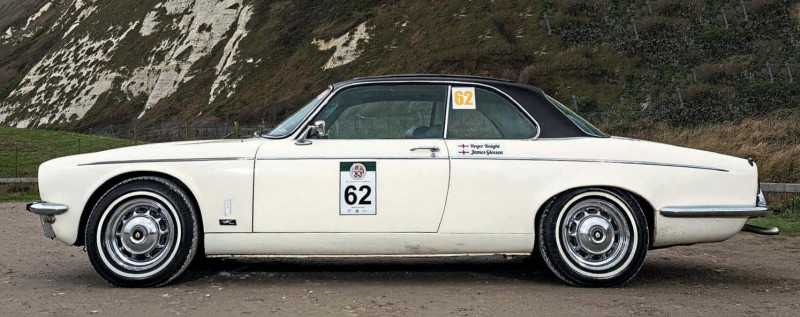
When Roger heard about the car in 2017, it was the son of the second owner who was responsible for it, but he didn’t know much about it, recalling it was a white Jaguar with two doors. What Roger discovered when he went to see it was a 4.2-litre XJ6C with a mere 10,667 miles on the clock.

“Upon opening the barn door after many years, we discovered a heavily dust-covered white Coupe,” says Roger. “There were pieces of timber on the roof and laid over the bonnet and boot. There was a hole in the barn roof allowing a fresh flow of rainwater to drip onto the passenger front wing, which was the worst affected panel on the car.”
The first challenge for Roger was to open the doors of the XJ6C. “It took a while for me to get the driver’s door open as the locks had corroded and I was concerned about breaking the keys – WD40 is marvellous stuff! Inside was a mess. Years of dust, which had found its way through the slightly open driver’s door window, plus the damp conditions had not helped, but thankfully the mice had not eaten anything. After some cleaning I was able to sit inside and check it out. Everything apart from one switch appeared to be there including the old radio cassette player. I also noticed the very last tax disc still in the window, dated 30 June 1992.”
Pushing the XJ6C out of the barn was not an option because the brakes were seized. Roger asked a friend to bring a flatbed recovery truck with a winch, but the XJ6C that weighs around 1.75 tons won the tug of war, leaving the truck to be pulled backwards. Eventually, a startling and loud crack-bang announced the unseizing of one or more of the brakes and the XJ6C was pulled out of the barn and taken away.
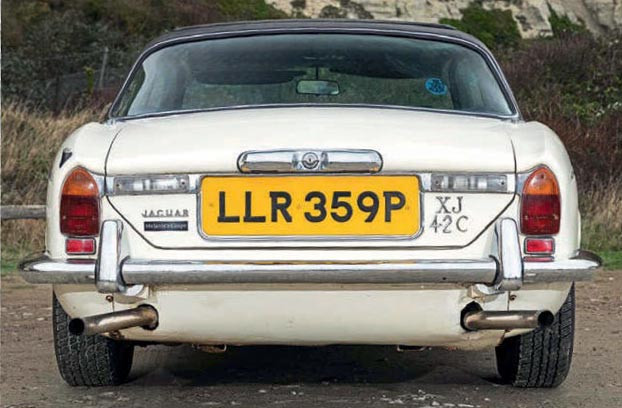
Five hours after the Jaguar had arrived at Roger’s home, he had the engine running courtesy of a new battery and by carefully pouring fresh petrol into the SU carburettors via a rubber tube and funnel.
“Upon opening the barn door after many years, we discovered a heavily dust-covered white Coupe,” says Roger. “There were pieces of timber on the roof and laid over the bonnet and boot. There was a hole in the barn roof allowing a fresh flow of rainwater to drip onto the passenger front wing, which was the worst affected panel on the car.”
The first challenge for Roger was to open the doors of the XJ6C. “It took a while for me to get the driver’s door open as the locks had corroded and I was concerned about breaking the keys – WD40 is marvellous stuff! Inside was a mess. Years of dust, which had found its way through the slightly open driver’s door window, plus the damp conditions had not helped, but thankfully the mice had not eaten anything. After some cleaning I was able to sit inside and check it out. Everything apart from one switch appeared to be there including the old radio cassette player. I also noticed the very last tax disc still in the window, dated 30 June 1992.”
Pushing the XJ6C out of the barn was not an option because the brakes were seized. Roger asked a friend to bring a flatbed recovery truck with a winch, but the XJ6C that weighs around 1.75 tons won the tug of war, leaving the truck to be pulled backwards. Eventually, a startling and loud crack-bang announced the unseizing of one or more of the brakes and the XJ6C was pulled out of the barn and taken away.
Five hours after the Jaguar had arrived at Roger’s home, he had the engine running courtesy of a new battery and by carefully pouring fresh petrol into the SU carburettors via a rubber tube and funnel.
Over the following nine months, which ran up to the end of 2017, Roger and friends sympathetically restored the XJ6C. These are difficult cars to restore because parts such as body panels can be hard to find in some cases. The aforementioned nearside front wing for example, was too rotten to rescue, but Roger managed to find a second-hand replacement.
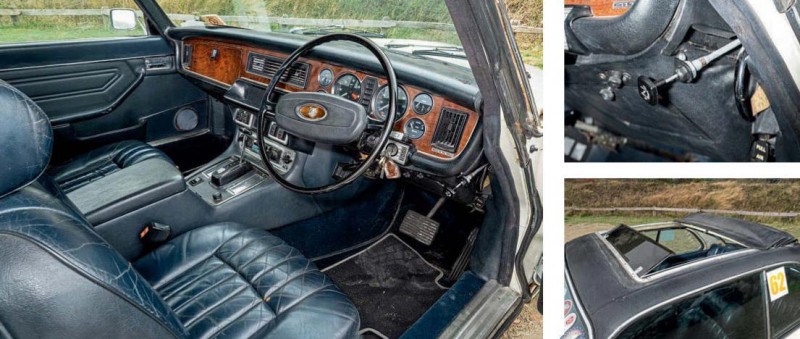
“Luckily, I have good friends in the business. For example, Tony Wilson, who can make and paint anything, came to the rescue, fabricating various body replacement panels, but most impressively, both the filler cap housing panels, made from a flat sheet of steel — truly a work of art.”
The rear subframe was removed as a complete assembly, including the differential, suspension and outboard disc brakes. Friends Dave Hill and his son Gary helped. Some welding repairs were needed around the inner wings and the two fuel tanks were replaced because they were beyond saving. “This led to a whole new fuel line from the tanks to the carbs, which in turn were dismantled and refurbished,” says Roger. The rear brakes along with the brake pipes were also replaced, and the suspension springs.
At the front, repairs included welding inside the inner wings and the strengthening brackets, fitting new brake discs, calipers and pipes, plus suspension springs and new whitewall tyres all round. The interior of the XJ6C had largely survived, consisting of dark blue leather upholstery. Even the non-factory Webasto sunroof was in fully serviceable condition, requiring a few hours to clean it up.
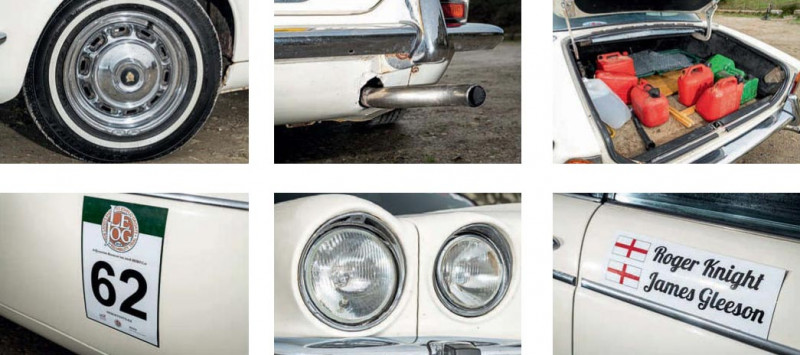
Once the rear subframe assembly had been refitted, Roger’s next plan was to have the exterior resprayed. He was confident the 4.2-litre XK engine and its BorgWarner automatic gearbox didn’t need an overhaul at this stage, although as mentioned, he did remove and strip the twin SU carburettors and converted the choke from automatic to manual. “This is a very simple conversion, which makes the world of difference to a common problem on the XJs,” he says. “It was £250 well spent.”
The respray in Old English White was completed by Tony Wilson and on the 22 February 2018, Roger’s XJ6C was back on the road and heading to his local MOT testing station, where it sadly failed on the windscreen wipers and washers, along with the aim of the nearside headlight and an insecure fuel pipe. These were promptly fixed, and the car passed the following day, although advisories for a perished fuel cap seal, a slightly deteriorated subframe mounting bush and a little play in the nearside rear wheel bearing remained listed.
Roger used his XJ6C for a few months but became suspicious of the XK engine as it didn’t seem to perform as well as he had expected.
“It seemed a little sluggish at times and on one long run it overheated,” he says. “It was time for a check-up, so it went back to Dave and Gary who suggested a local engine specialist who was confident it could be rebuilt. Removing a 4.2-litre XK engine requires a hoist. These are heavy lumps and after a morning’s work it was ready to go off to the specialist.” The engine rebuild included a conversion to run on unleaded petrol.

It was by now September 2018 and Roger and Jim had paid their entry fees to compete in the Land’s End to John O’Groats reliability trial (LeJog) at the beginning of December, which was organised by the Historic Endurance Rallying Organisation (HERO) and the Endurance Rally Association (ERA).With a handful of classic Jaguars to choose from, he did consider using his Mk 2, but realised the XJ6C offered more refinement. On reflection, Roger jokes, “LeJog was actually the running-in period for the rebuilt engine. Probably not ideal but certainly a good test.”
Some preparation work was required to kit out the XJ6C for LeJog, including the fitting of winter tyres to cope with mud and snow, tripmeters and a timer, a tow rope, fire extinguisher, petrol cans, breakdown signs and a sticker to show where to fit a towing hook or rope.
On Wednesday 5 December 2018, Roger and Jim set off to Land’s End, leaving plenty of time to get there in time for the start of LeJog on the Saturday (paperwork and other preparation would take up plenty of time prior to the start).
Living on the south-east coast of England, Roger and Jim had a 365-mile drive to simply get to the start of LeJog, and that was before they would need to drive some 1,600 miles to the top corner of Scotland via Wales and then return home, which was a further 750 miles. The XJ6C would need to transport them for roughly 2,700 miles in the space of a week, or to put it another way, it had to cover roughly one fifth of the total mileage it had ever driven since 1976. No pressure then.
The drive to Land’s End went reasonably smoothly, helping to shake the XJ6C down and identify some minor issues. The first was an inoperative tripmeter. It had been removed from Roger’s Mk 2 and he suspected the linkage cable between the speedo and Brantz meter may have been damaged, so a new one was ordered and delivered to the hotel he and Jim would be staying at. “If that didn’t work, we would be out of the rally before it had even begun, so we were a little worried,” he explains.
During the drive over to Land’s End, it became apparent the accelerator cable had started to feel as though it was sticking. A look under the bonnet revealed it was frayed at one end, so it was catching slightly on the inner side of the sleeve when applying pressure on the accelerator.
The XJ6C made it to Land’s End with plenty of time to spare for repairs, paperwork and scrutineering. A local garage was asked to help with the problems found on the journey over.
“The staff there were brilliant and let us use a pit to check the car,” says Roger.
“There was nothing we could do about the accelerator cable, so we left that to fate.” As for the tripmeter, “On inspection, we found that the wiring was at fault, not the meter or the fitting, and by simply switching the wires, Jim had all the rally meters glowing in perfect harmony. We were back in the rally.”
After calibrating the tripmeter, Roger and Jim returned to their hotel where more competitors were arriving. They soon discovered they were the only pair who had never competed in a rally before.
“Not for the first time, Jim and I wondered what we had let ourselves in for,” says Roger. “We spoke to a number of fellow competitors, all of whom were shocked to hear that we had never been on any kind of rally before.”
Scrutineering raised even more eyebrows for Roger and Jim. “All the other cars entered had been specially prepared for the event and were not totally standard like ours. Some even had roll cages, rally seats and full harnesses.”
Fortunately, the XJ6C passed scrutineering, which took 15 minutes and made sure the correct winter tyres had been fitted, along with all the safety items and as Roger laughs, “to check our car had not been advantageously modified — that made us smile.”
On the following day, the Friday, which was the day before the event began, it was time to fit the door stickers, attend a briefing aimed at novices and collect maps and other information. Roger and Jim had to work out their routes from what they had been given. One hour after the last competitors had left, they were still in the room where the maps and information had been distributed, figuring out their routes.
On the day of the start of LeJog, the first competitors began setting off at one-minute intervals from 7.30am. Roger and Jim were in Class 9, which included saloons over 2,000cc, and it was the last group to leave. It was raining, plus it was windy and there wasn’t much daylight. Numerous MGs, Fords, Volvos andMinis made their way to the start-line and left. Eventually, it was the turn of the one and only XJ6C in the event, although there were two other classic Jaguars – a 1959Mk 1 and an XJ-S.
“The plan was for us to start at 8:32am on Saturday and finish at 11:32am the following Tuesday morning,” says Roger. “This we understood, but what we didn’t realise was that two hours’ sleep was considered a luxury.”
Roger was behind the wheel for the start, although the plan all along was to share driving and navigation with Jim. “We pushed on to the first regularity and this turned out to be a bit of a shock, with tight back roads and rivers of muddy water running across them, before taking off into fields and farmland. The tests were always against the clock and often on the sort of dodgy surfaces I would never normally have dreamt of taking the XJC.”
Two hours later and the pair were eating cake and drinking tea, but there wasn’t much time to relax and they were soon back in the Jaguar. “After the first few hours on the road, we concluded that it was, in fact, very hard, but we battled on against the elements, with crews in front of and behind us who obviously knew what they were doing.” After driving through Cornwall, Devon and into Wales, the end of leg 1 was at the Welsh coastal resort of Abergavenny.
It was 7.30pm on the Saturday and there was a two-hour break for food and drink before the XJ6C was back on the road, heading east to Telford with several tests and regularities to complete along the way. Occasional wrong turns saw the Jaguar spinning its wheels in muddy fields, but the HERO-ERA mechanical assistance crews for the event miraculously turned up at the right time and pulled the car out of trouble.
Other calamities that arose included the electric windows not working. The lighting for the dashboard instruments failed, so the courtesy lights were switched on to illuminate them. Then, with 100 miles to go before the end of day one, the windscreen wipers stopped working. It was still pouring with rain and it was midnight. Roger and Jim decided to abandon the remaining activities and carefully head to the hotel in Telford. On the way, they spotted another competitor in a Mercedes 220SE. The driver and navigator were lost, so everyone agreed to head to the hotel. This meant the XJ6C had a car to guide them, so they arrived in convoy at 4am on the Sunday.
After a couple of hours of sleep, Roger and Jim tracked down the support mechanics to see if they could help with the inoperative windscreen wipers. They discovered the wiper motor cable had broken, so it wasn’t an easy fix. Neither was the sticking throttle cable or the lack of electric windows and instrument lighting (water ingress for the last two).
“We were told about the rain-clearing effect of the humble potato when smeared on a windscreen so, to much amusement, we got hold of some spuds and rubbed them all over the screen,” says Roger. “I was not entirely convinced, so we located a local Halfords and bought some Rain-X, too, which was probably a better bet. However, by this time the rally gods were on our side and the rain stopped completely.”
After refuelling and assuming they were ready for day two, the rally clocks stopped working. This time it was some loose wires, but they had shorted out, so they had to be repaired and the blown fuses bypassed. With fingers and toes crossed, they worked again.
The wiring issue meant Roger and Jim were an hour late for the start of day two, so they had to make up some time and tried crossing a field instead of taking the longer route around by road in a bid to shave off some 20 minutes. It worked, but the muddy field resulted in damage to the exhaust system. One of the rear silencers had become detached, so as Roger recalls, “The XJ6C now sounded like a real rally car and there was nothing to do but push on north and hope nothing else went wrong.”
Pushing on worked for day two and the XJ6C made it all the way to Hexham for 9.30pm on the Sunday. On the next day, the exhaust was temporarily fixed by shoving the pipe back into the silencer. One of the headlights was damaged and inoperative, but at 9.32am on the Monday, the XJ6C was heading off to Scotland, making it to Fort William at 11.30pm for a two-hour break. The lack of windscreen wipers meant that Roger and Jim had to occasionally stop and clean the glass, but at least it wasn’t raining.
With some ten hours remaining to the finish at John O’Groats, the XJ6C set off at 1.30am on the Tuesday morning. But there were several gruelling tests ahead. “The temperature had dropped and there was ice on the roads as we started the stage,” says Roger. “We headed off across some breathtaking countryside but you don’t see much of it because your concentration has to be dedicated to the 20 metres of non-existent road ahead of you on the map.”
This was definitely a gruelling rally and Roger recalls passing numerous competitors whose cars had been damaged by hitting rocks, walls or other cars. The XJ6C got off lightly when it clipped a boulder, scraping and reshaping the nearside sill and the bottom of the passenger door.
With some 120 miles of road driving remaining, plus an additional 100 miles of regularities and speed tests, Roger and Jim decided to err on the side of caution and avoid any heroic driving, completing what they could in the time remaining. At 11.30am on the Tuesday morning, the finish line was in sight, so with Jim at the wheel, Roger drew back the sunroof and stood up to wave. 69 hours and 1,600 miles since leaving Land’s End, they had made it to the top right corner of Scotland.
“Tony Jardine and the film crew [who were covering the event on behalf of the organisers] rushed over to interview us, and he insisted on a photo with us and the Coupe,” says Roger. “We drove through the finish arch and were presented with, a Parker pen.”
The evening celebrations for the end of the event took place at a hotel in Wick where Roger and Jim shared a table with Tony and his team. The awards ceremony made the rookie pair realise that some people take this event seriously and that several drivers and navigators had only met at the event because they were part of an organised team. Whilst all the awards were passing by Roger and Jim, who had finished a commendable 45th (from the 71 entrants, 51 finished), they were surprised to receive the Spirit of the Rally Award.
The following day at 6am saw the XJ6C heading for home. 13 hours later, it was all over, but not before the Jaguar had ground to a lifeless halt before the Dartford crossing. The alternator had stopped recharging the battery, but after the RAC had arrived and hit it, the XJ6C was back on the road.
The total distance covered from door-to-door was a staggering 2,708 miles, which cost £1,200 in petrol. Roger and Jim believe it was worth every penny and they are now planning to attend this year’s event in December with a 1990 3.6-litre XJ-S, which as Roger comments, “will be prepared with some experience in mind.”
BELOW LEFT: 4.2-litre XK engine was last stripped and rebuilt in 2018
BELOW RIGHT: Rookie rally drivers no more: Roger Knight on the left and Jim Gleeson on the right
BELOW L-R: Whitewall tyres were replaced With mud and snow tyres for LeJog and saved hours of cleaning
Offside rear tail pipe took a hammering on LeJog, but has since been repaired
Spare fuel cans were a necessity for the £1,200 spent on petrol for LeJog
Mud-splattered and battered XJC at the end of the rally. Painter Tony Wilson must have been spitting feathers
A happy-looking Roger and Jim during the LeJog rally. Times were often more testing, but the pair kept laughing all the way to the end
Tony Jardine (centre) was amazed the XJ6C finished the rally with two rookie competitors and made a point of congratulating them.
BELOW: Dark blue leather-upholstered interior has remained standard and survived the gruelling LeJog, whereas-many competitors came equipped with racing seats, harnesses and roll cages
Manual choke conversion cost around £250 Webasto sunroof is a non-factory addition and enabled Roger to stand up and wave when Jim drove over the finish line
Found in a barn after 25 years of being stored away, the XJ6C only had 10,667miles on the clock, but the brakes were seized and various bits of bodywork had corroded
The upholstery had survived and only needed a thorough clean. Original dark blue leather trim was refitted and provided some luxury for the LeJog rally
Nearside front wing had been subjected to dripping water for 25 years, so it was beyond repair. Luckily, Roger managed to find a secondhand replacement
Rolled off the flatbed recovery truck and back at Roger’s home, the 4.2-litre XK engine was up and running some five hours later thanks to a new battery and fresh petrol
Rear subframe assembly was fully removed, allowing the brakes and suspension to be overhauled. Welding repairs were needed inside the inner wings
After the rebuild and respray, Roger decided to haul the XK engine out and have it rebuilt. Despite its low mileage, it felt sluggish and potentially troublesome.

